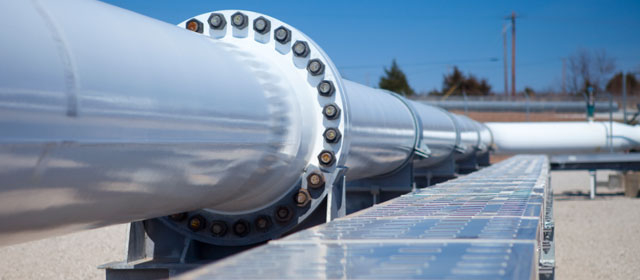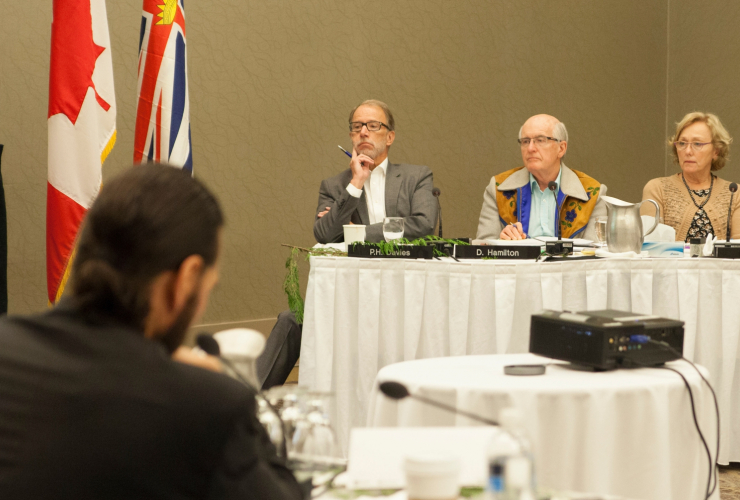TransCanada Corporation’s proposed Energy East pipeline would have a 15 per cent chance of rupturing annually that could produce a potentially catastrophic oil spill, according to a new briefing paper the Council of Canadians released Wednesday.
“Fifteen per cent a year is a very high level of risk,” said Mark Calzavara, the Council of Canadians’ regional organizer for Ontario and Quebec.
The proposed Energy East pipeline would transport 1.1 million barrels per day of crude oil from the Alberta tar sands some 4,600 kilometres to a new export terminal in Saint John, New Brunswick.
The council’s report maintains that TransCanada can only detect leaks greater than 1.5 per cent of the pipeline capacity.
“The math is easy,” Calzavara said. “One-point-five per cent of 1.1 million barrels of oil per day works out to 2.6 million litres. Anything under that, there’s no assurance their system would actually work at detecting it.
”That’s a massive leak, though, because the pipeline is so big. That’s a huge amount of oil.”
State of the art monitoring system described as less accurate than a bathroom scale
But Tim Duboyce, TransCanada’s spokesperson, disputes the council’s report, calling its conclusion “unfounded.”
Duboyce said the council doesn’t understand how pipelines work, but that it was very clear what they want to do: “They attack the pipeline project at every turn because they want to stop it from happening. Quite frankly, they’ve manufactured this notion with this paper they put out today that’s built on faulty premises.”
DuBoyce wouldn’t speculate what the percentage of ruptures annually might occur on the pipeline, calling the council’s premise “faulty. It’s wrong. We believe we can operate pipelines safely without having spills.”
He also took issue with the council’s description of TransCanada’s “state-of-the-art” monitoring system being “less accurate than the average bathroom scale.”
TransCanada has spent $1 billion on safety and maintenance of its infrastructure, Duboyce said, adding that inspection measures include cylindrical robots that travel the pipelines on a regular basis, testing for and scanning for anomalies within the lines.
Those robots can detect an anomaly as small as a little sliver of fingernail, Duboyce said.
Referring to the council, Duboyce said, “I’m not sure where they’re drawing all their statistics from, but they are overblowing the risk associated with this. I’d just underscore that we aim for zero incidents.
“It’s in our interests as well as everybody else’s that we do aim for that kind of performance level, because we don’t want anything to happen to the environment.”
A pump station failure sent a geyser of oil into the air
A Polaris Institute report in June 2015 on TransCanada noted that according to the National Energy Board (NEB), 17 of the 39 major pipeline accidents in Canada from 1992 to 2014 occurred on pipelines either TransCanada or its subsidiary, NGTL, owned.
CBC News carried out an investigation in 2013 that went beyond the NEB numbers, disclosing 1,047 pipeline incidents in Canada, of which 364 were related to TransCanada or NGTL.
The Polaris report described TransCanada “as a relative newcomer to oil pipelines” and reported that according to the company’s own data between 2010 and 2013 in the U.S. and Canada it spilled 441.7 barrels of oil in 152 different spills.
Polaris also mentioned 12 spills on TransCanada's Keystone mainline in its first year of operation. The biggest took place in North Dakota on May 7, 2011, where a pump station failure caused a 60-foot eruption of oil, amounting to some 79,500 litres, or 400 barrels.
“According to TransCanada, this did not count as a spill because the oil did not come from the pipe itself,” the Polaris report noted.
The council’s paper pointed to possible causes of a potential catastrophic oil spill along the proposed Energy East pipeline, which along the route would include an existing up-to-40-year-old natural gas pipeline from Saskatchewan to Ontario.
In 1995, in Rapid City, Manitoba, one of TransCanada’s natural gas mainlines ruptured and exploded, causing damage to an adjacent line. The council noted that for much of Energy East’s planned route, the converted gas pipeline will run within metres of other pipelines carrying natural gas.
“Nearly half of the ruptures on the Mainline were a result of stress corrosion and cracking, external corrosion, and coating and welding failures,” the council’s paper noted. “This raises clear concerns about the design, construction and maintenance of these pipelines.”
External corrosion is the second leading cause of pipeline failures
Duboyce dismissed those concerns, saying that the council is talking about equipment that was developed and built mainly in the 1980s and ‘90s. “Age of a pipeline is not a good reference for determining its safety.”
According to Duboyce, TransCanada monitors the state of its pipelines from both within and without and as the lines need to be repaired or replaced, the work is done before anything happens.
“For us it’s absolutely important to build safe pipelines and when you look at the technology today at our disposal while we develop Energy East, I think we can look forward to what will be one of the most technologically advanced and safest pipelines ever built in the world.”
However, the Polaris Institute report flags aging infrastructure as a concern. The report cites an August 2013 Alberta Energy Regulator performance review that mentions age as a factor contributing to pipeline failure.
The Alberta Energy Regulator wrote that “external corrosion is the second leading cause of pipeline failures, at 12. 7 per cent, and is primarily due to external pipeline coatings falling from either age or excessive production temperatures.”





Comments